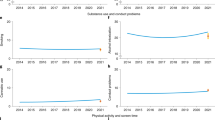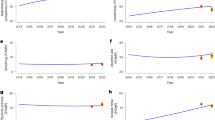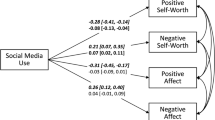Abstract
OBJECTIVE:
To examine relationships between body mass index (BMI) and psychological correlates in Chinese school adolescents during the period of economic transition.
DESIGN:
Baseline data of 1655 Chinese adolescents aged 11–15 y were retrieved from a longitudinal smoking cessation and health promotion program in Wuhan, China. Assessments of body weight and height, depressive symptoms, perceived peer isolation (PPI) and perceived availability of social support (PASS) were collected.
RESULTS:
Based on the International Obesity Task Force (IOTF) age-and sex-specific BMI cutoffs, 12.5% of boys and 9.2% of girls were overweight. In girls, high BMI was significantly related to higher self-reported depressive symptoms, and was dominantly mediated by PPI. On the contrary, high BMI boys reported significantly lower levels of PPI although high PPI level aggravated depressive symptoms. For both girls and boys, the observed effect of PPI on the relationship between BMI and depressive symptoms was sustained only in low PASS boys and girls.
CONCLUSIONS:
The present study revealed different effects of PPI on the association of BMI and depressive symptoms between boys and girls, which were buffered by levels of PASS. The findings of this study may contribute to our understanding of the influences of psychological correlates in pediatric overweight in the Eastern cultural environment.
This is a preview of subscription content, access via your institution
Access options
Subscribe to this journal
Receive 12 print issues and online access
$259.00 per year
only $21.58 per issue
Buy this article
- Purchase on Springer Link
- Instant access to full article PDF
Prices may be subject to local taxes which are calculated during checkout

Similar content being viewed by others
References
Popkin BM, Doak CM . The obesity epidemic is a worldwide phenomenon. Nutr Rev 1998; 56 (Part 1): 106–114.
Carpenter KM, Hasin DS, Allison DB, Faith MS . Relationships between obesity and DSM-IV major depressive disorder, suicide ideation, and suicide attempts: results from a general population study. Am J Public Health 2000; 90: 251–257.
Erickson SJ, Robinson TN, Haydel KF, Killen JD . Are overweight children unhappy? Body mass index, depressive symptoms, and overweight concerns in elementary school children. Arch Pediatr Adolesc Med 2000; 154: 931–935.
Faith MS, Matz PE, Jorge MA . Obesity-depression associations in the population. J Psychosomatic Res 2002; 53: 935–942.
Roberts RE, Kaplan GA, Shema SJ, Strawbridge WJ . Are the obese at greater risk for depression? Am J Epidemiol 2000; 152: 163–170.
Roberts RE, Deleger S, Strawbridge WJ, Kaplan GA . Prospective association between obesity and depression: evidence from the Alameda County Study. Int J Obes Relat Metab Disord 2003; 27: 514–521.
Strauss RS . Childhood obesity and self-esteem. Pediatrics 2000; 105: e15.
Istvan J, Zavela K, Weidner G . Body weight and psychological distress in NHANES I. Int J Obes Relat Metab Disord 1992; 16: 999–1003.
Doak CM, Adair LS, Monteiro C, Popkin BM . Overweight and underweight coexist within households in Brazil, China and Russia. J Nutr 2000; 130: 2965–2971.
Popkin BM . Nutrition in transition: the changing global nutrition challenge. Asia Pac J Clin Nutr 2001; 10 (Suppl): S13–S18.
Popkin BM, Keyou G, Zhai F, Guo X, Ma H, Zohoori N . The nutrition transition in China: a cross-sectional analysis. Eur J Clin Nutr 1993; 47: 333–346.
Wang Y, Ge K, Popkin BM . Tracking of body mass index from childhood to adolescence: a 6-y follow- up study in China. Am J Clin Nutr 2000; 72: 1018–1024.
Xie B, Liu C, Chou CP, Xia J, Spruijt-Metz D, Gong J, Li Y, Wang H, Johnson CA . Weight perception and psychological factors in Chinese adolescents. J Adolesc Health 2003; 33: 202–210.
Xing YM, Gao FX, Li HJ, Qiang M . Effect of obesity on personality and behavior of children. J Shanxi Med Univ 2000; 31: 314–315.
Yu YZ, Hu YZ, Liang SY, Zhang L, Zhou LM, Zhang JZ . A case–control study on psychological behavioral characteristics in obese adolescents. Chinese J Psych & Health 1996; 10: 70–71.
Zhang HB, Tao FB, Zeng GY, Cao XQ, Gao M, Shao FQ . Effects of depression symptoms and other psychological factors on unhealthy weight reducing behaviors of adolescents. Chinese J School health 2000; 21: 348–349.
Strauss RS, Pollack HA . Social marginalization of overweight children. Arch Pediatr Adolesc Med 2003; 157: 746–752.
Gortmaker SL, Must A, Perrin JM, Sobol AM, Dietz WH . Social and economic consequences of overweight in adolescence and young adulthood. [see comments.]. N Engl J Med 1993; 329: 1008–1012.
Taylor CB, Sharpe T, Shisslak C, Bryson S, Estes LS, Gray N, McKnight KM, Crago M, Kraemer HC, Killen JD . Factors associated with weight concerns in adolescent girls. Int J Eating Disord 1998; 24: 31–42.
Neumark-Sztainer D, Story M, Faibisch L . Perceived stigmatization among overweight African-American and Caucasian adolescent girls. J Adolesc Health 1998; 23: 264–270.
Neumark-Sztainer D, Falkner N, Story M, Perry C, Hannan PJ, Mulert S . Weight-teasing among adolescents: correlations with weight status and disordered eating behaviors. Int J Obes Relat Metab Disord: J Int Assoc Study Obes 2002; 26: 123–131.
Pearce MJ, Boergers J, Prinstein MJ . Adolescent obesity, overt and relational peer victimization, and romantic relationships. Obes Res 2002; 10: 386–393.
Thompson JK, Coovert MD, Richards KJ, Johnson S, Cattarin J . Development of body image, eating disturbance, and general psychological functioning in female adolescents: covariance structure modeling and longitudinal investigations. Int J Eating Disord 1995; 18: 221–236.
Cohen S . Psychosocial models of the role of social support in the etiology of physical disease. Health Psychol 1988; 7: 269–297.
Unger JB, Yan L, Chen X, Jiang X, Azen S, Qian G, Tan S, Jie G, Sun P, ChunHong L, Chou CP, Zheng H, Anderson Johnson C . Adolescent smoking in Wuhan, China: baseline data from the Wuhan Smoking Prevention Trial. Am J Prev Med 2001; 21: 162–169.
Cole TJ, Bellizzi MC, Flegal KM, Dietz WH . Establishing a standard definition for child overweight and obesity worldwide: international survey. BMJ 2000; 320: 1240–1243.
Poskitt E . Defining childhood obesity: the relative body mass index (BMI). Acta Paediatr 1995; 84: 961–963.
Ge K . The dietary and nutritional status of Chinese population–children and adolescents (1992 national Nutrition Survey). People's Medical Publishing House: Beijing; 1999. pp 473.
Melchior LA, Huba GJ, Brown VB, Reback CJ . A short depression index for women. Educ Psychol Meas 1993; 53: 1117–1125.
Cheung CK, Bagley C . Validating an American scale in Hong Kong: the Center for Epidemiological Studies Depression Scale (CES-D). J Psychol 1998; 132: 169–186.
Holmbeck G . Toward terminology, conceptual, and statistical clarity in the study of mediators and moderators: examples from the child-clinical and pediatric psychology literatures. J Consulting Clin Psychol 1997; 65: 599–610.
Baron R, Kenny D . The moderator-mediator variable distinction in social psychological research: conceptual, strategic and statistical considerations. J Personality Soc Psychol 1986; 51: 1173–1182.
MacKinnon D, Dwyer JH . Estimating mediated effects in prevention studies. Evaluation Rev 1993; 17: 144–158.
MacKinnon DP . Analysis of mediating variables in prevention and intervention research. NIDA Res Monogr 1994; 139: 127–153.
Judd C, Kenny D . Process analysis: estimating mediation in treatment evaluations. Evaluation Rev 1981; 5: 601–619.
Reynolds K, Bishop DB, Chou C, Xie B, Nebeling L, Perry CL . Contrasting mediating variables in two 5-a-day nutrition intervention programs. Prev Med 2004; 39: 882–893.
Sobel ME . Direct and indirect effects in linear structural equation models. Sociol Methods Res 1987; 15: 151–176.
MacKinnon D, Krull JL, Lockwood CM . Equivalence of the mediation, confounding and suppression effect. Prev Sci 2000; 1: 173–181.
Pentz MA, Chou C . Measurement invariance in longitudinal clinical research assuming change from development and intervention. J Consulting Clini Psychol 1994; 62: 450–462.
Bentler PM . EQS structural equations program mannual. Multivariate Software, Inc: Encino, CA; 1995.
Thompson JK, Coovert MD, Stormer SM . Body image, social comparison, and eating disturbance: a covariance structure modeling investigation. Int J Eating Disord 1999; 26: 43–51.
Neumark-Sztainer D, Wall MM, Story M, Perry CL . Correlates of unhealthy weight-control behaviors among adolescents: implications for prevention programs. Health Psychol 2003; 22: 88–98.
Ravaja N, Keltikangas-Jarvinen L, Viikari J . Perceived social support and abdominal fat distribution in adolescents and young adults: a structural equation analysis of prospective data. Appetite 1998; 31: 21–35.
Yuan KH, Bentler PM . Three likelihood-based methods for mean and covariance structure analysis with non-normal missing data. In: Sociological methodology 2000. American Sociological Association: Wasgubgtibm DC; 2000.
Jamshidian M, Bentler PM . ML estimation of mean and covariance structures with missing data using complete data routines. J Educ Behav Stati 1999; 24: 21–41.
Byrne BM . Structural equation modeling with eqs and eqs/windows: basic concepts, applications, and programming. BMDP Statistical Software, Inc: Los Angeles, CA; 1994.
Rhyne-Winkler MC . Eating attitudes in fourth-, sixth, and eigth-grade girls. Elem Sch Guidance Couns 1994; 28: 285–294.
Buddeberg-Fischer B, Klaghofer R, Reed V . Associations between body weight, psychiatric disorders and body image in female adolescents. Psychother Psychosom 1999; 68: 325–332.
Li SF, Zhao Y . Dietary nutrition of 86 obese children and behavioral change. J Shangong Med Univ 2000; 1: 30–32.
Britz B, Siegfried W, Ziegler A, Lamertz C, Herpertz-Dahlmann BM, Remschmidt H, Wittchen HU, Hebebrand J . Rates of psychiatric disorders in a clinical study group of adolescents with extreme obesity and in obese adolescents ascertained via a population based study. Int J Obesi Relat Metab Disord: J Int Assoc Study Obes 2000; 24: 1707–1714.
Faith MS, Flint J, Fairburn CG, Goodwin GM, Allison DB . Gender differences in the relationship between personality dimensions and relative body weight. Obes Res 2001; 9: 647–650.
Nowak M, Speare R, Crawford D . Gender differences in adolescent weight and shape-related beliefs and behaviours. J Paediatr Child Health 1996; 32: 148–152.
Felts WM, Parrillo AV, Chenier T, Dunn P . Adolescents' perceptions of relative weight and self-reported weight- loss activities: analysis of 1990 YRBS (Youth Risk behavior Survey) national data. J Adolesc Health 1996; 18: 20–26.
Stevens J, Alexandrov AA, Smirnova SG, Deev AD, Gershunskaya Yu B, Davis CE, Thomas R . Comparison of attitudes and behaviors related to nutrition, body size, dieting, and hunger in Russian, black-American, and white-American adolescents. Obes Res 1997; 5: 227–236.
Story M, Hauck FR, Broussard BA, White LL, Resnick MD, Blum RW . Weight perceptions and weight control practices in American Indian and Alaska Native adolescents. A national survey. Arch Pediatri Adolesc Med 1994; 148: 567–571.
Rinderknecht K, Smith C . Body-image perceptions among urban Native American youth. Obes Res 2002; 10: 315–327.
Lee S, Lee AM . Disordered eating in three communites of China: a comparative study of female high school students in Hong Kong, Shenzhen, and Rural Hunan. Int J Eat Disord 1999; 27: 317–327.
Cossrow NH, Jeffery RW, McGuire MT . Understanding weight stigmatization: a focus group study. J Nutr Educ 2001; 33: 208–214.
Cohen S, Wills TA . Stress, social support, and the buffering hypothesis. Psychological Bull 1985; 98: 310–357.
DuBois D, Burk-Braxton C, Swenson LP, Tevendale HD, Lockerd EM, Moran BL . Getting by with a little help from self and others: self-esteem and social support as resources during early adolescence. Dev Psychol 2002; 38: 822–839.
Author information
Authors and Affiliations
Corresponding author
Additional information
This study was supported by the National Cancer Institute/National Institute of Drug Abuse Transdisciplinary Tobacco Use Research Center Grant (1 P50 CA84735-01) awarded to the University of Southern California.
Rights and permissions
About this article
Cite this article
Xie, B., Chou, CP., Spruijt-Metz, D. et al. Effects of perceived peer isolation and social support availability on the relationship between body mass index and depressive symptoms. Int J Obes 29, 1137–1143 (2005). https://doi.org/10.1038/sj.ijo.0803006
Received:
Revised:
Accepted:
Published:
Issue Date:
DOI: https://doi.org/10.1038/sj.ijo.0803006
Keywords
This article is cited by
-
Are changes in body-mass-index associated with changes in depressive symptoms? Findings of a population-based longitudinal study among older Germans
BMC Psychiatry (2018)
-
Body mass index and depressive symptoms in adolescents in Taiwan: testing mediation effects of peer victimization and sleep problems
International Journal of Obesity (2017)
-
Depressive symptoms, body composition and bone mass in young adults: a prospective cohort study
International Journal of Obesity (2017)
-
Socioeconomic determinants of childhood obesity among primary school children in Guangzhou, China
BMC Public Health (2016)
-
Adolescents' experience of comments about their weight – prevalence, accuracy and effects on weight misperception
BMC Public Health (2009)



